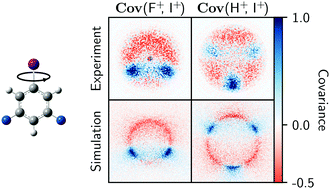Predicting Coulomb explosion fragment angular distributions using molecular ground-state vibrational motion
Abstract
Laser-induced Coulomb explosions can be used to identify gas-phase molecular structures through correlations between fragment ion trajectories. This report presents a model for predicting these outcomes, which first establishes the neutral equilibrium geometry of a target molecule using electronic structure calculations, and then samples a probability distribution of potential ground-state configurations by allowing for zero-point vibrational motion. Candidate structures are assumed to explode instantaneously into charged fragments, and the simulated ion trajectories are correlated using recoil-frame covariance analysis. The effects of detection efficiency and fluctuating experimental conditions are also considered. The results were found to match experimental data, indicating that Coulomb explosion fragment angular distributions produced from highly-charged ions depend largely on the internal motion of the target molecule.

- This article is part of the themed collections: Ions, electrons, coincidences and dynamics: Festschrift for John H.D. Eland and 2022 PCCP HOT Articles


 Please wait while we load your content...
Please wait while we load your content...